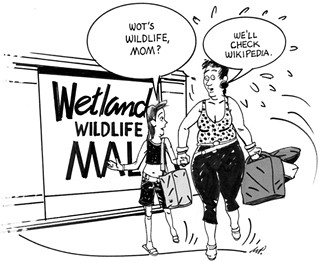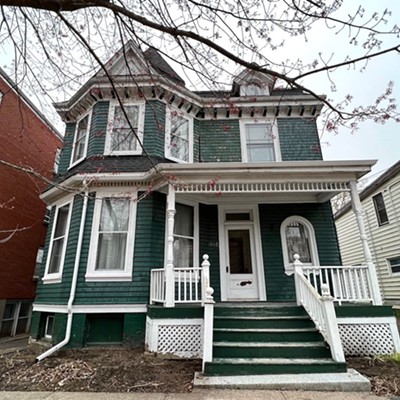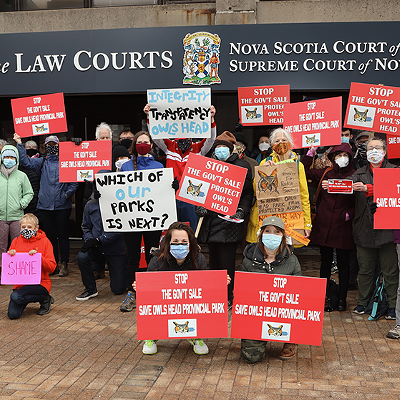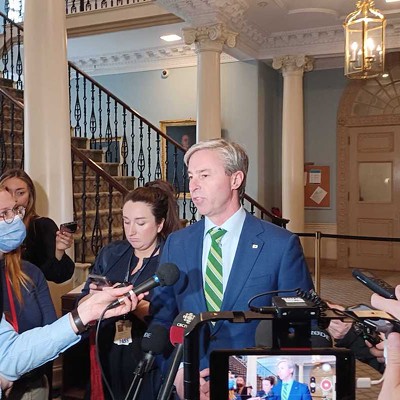In HRM's vanishing wildlands, excavators rumble relentlessly across scarred landscapes. The destruction of natural habitat in and around HRM's sprawling suburbs is so routine it's rarely even newsworthy. Yet once in a blue moon, a determined citizen can make a big difference. On the weekend of June 6, Sackville resident Marilyn Challis spotted one of the yellow-black excavators filling in part of a wetland. The wetland was wedged between the busy controlled-access highway known as Duke Street and a burgeoning big-box shopping complex that houses the Bedford Walmart. Challis called a 1-800 number at the Nova Scotia environment department and emailed local politicians. She pointed out that the wetland is home to heron, egret and a rare frog species. On Monday, June 8, HRM issued a stop-work order halting the excavator in its tracks and sending municipal planners and the developer to the negotiating table. It was a round one victory for Marilyn Challis.
In his book The Geography of Nowhere, James Howard Kunstler argues that destruction is at the heart of suburban development. Our environmental laws even provide for it. In the case of the Duke Street wetland, developer Besim Halef received permission from the province to fill in half an acre of wetland, part of the site for a 140-room Holiday Inn. A spokesperson for the provincial environment department says Halef agreed to pay $17,000 to the Nova Scotia Environmental Trust Fund, which finances environmental research, management and conservation. The developer was also required to install barriers to prevent silt from entering the other half of the wetland.
But Bedford has a unique set of restrictions governing construction near water. When he started construction last month with provincial permission, Halef himself says he didn't know about the municipality's rules. Challis's complaints and the HRM stop-work order forced him to rethink his project. He says he's hoping to reach a deal next week with city officials that will lead to the restoration of the damaged wetland and the relocation of the hotel. If that happens, it's a rare case of citizen complaints, political lobbying and the sensitivity of a developer combining to save natural habitat in an area where the destruction of nature is an everyday occurrence. The new hotel itself is on the edge of the Bedford Commons, with its big-box stores and many acres of parking convenient for seven-day-a-week car-borne shoppers. Although the wetland seems to have been saved, rising suburban land values, rampant consumerism and the shortsightedness of politicians have inevitably led to the paving of vast tracts of countryside for highways, malls, parking lots---and housing.
In HRM for example, thousands of McMansions are being thrown up every year on lots newly carved out of the woods. The big cutting machines take less than two minutes to saw off, strip and stack an 80-year-old tree. Then come the excavators, dump trucks and dozers, followed at last by families in their shiny SUVs. These days HRM routinely allows developers to build three-bathroom homes without access to municipal water or sewage services. In many suburban areas, such as Fall River and Beaver Bank, there are chronic water shortages as wells run dry and angry residents demand relief.
"What's happening is that there's no organized plan," says Walter Regan of the Sackville Rivers Association. "Just one subdivision after another." Regan predicts large chunks of HRM will end up looking like Mississauga. "We're destroying brooks and streams, cutting down trees and infilling wetlands," he says. "I have yet to see any signs of it slowing down."
James Howard Kunstler argues the whole suburban economy will collapse when oil supplies peak and energy prices shoot skyward. In his book The Long Emergency, Kunstler predicts that many suburban subdivisions will become the slums of the future. That's the bleak long-term view. In the short term, citizens of Bedford/Sackville can celebrate a victory. Looks like the rare frogs in the Walmart bog have been saved, thanks to Marilyn Challis!





















